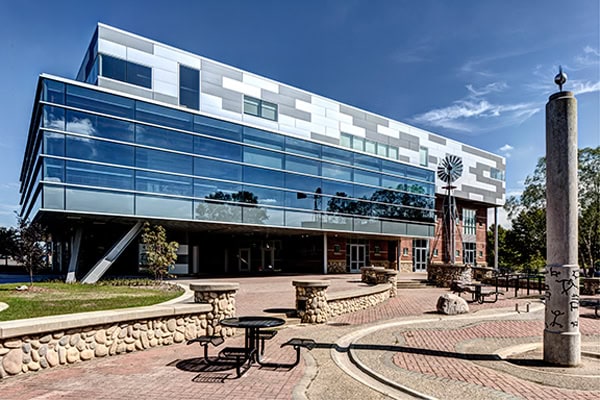
[Image above] The former site of Cereal City USA is experiencing a second life as a STEM center, thanks to a $14-million donation and Guardian Industries’ SunGuard glass. Credit: Justin Maconochie
It’s far from summer, so roadtripping is likely about the furthest thing from top of mind.
But for those of you who like to plan ahead (or just need something other than snow and slush to occupy your thoughts), have you visited RoadsideAmerica.com?
We’ve spent some time on the site, and rightfully so, since our headquarters are home to the world’s largest crystal ball. (FYI: The crystal ball hasn’t been removed “because too many people stopped to look at it.” Though the Ross C. Purdy Museum of Ceramics may be closed, the 700-lb, 573-mm, precision optical glass ball designed by Christopher Ries at Schott Glass Technologies still has a hallowed home in our lobby.)
Another museum, now shuttered, that’s found at least 15 minutes of online fame is Kellogg’s Cereal City USA in Battle Creek, Michigan. The “$22 million breakfast food funhouse” opened its doors in 1998—a good year for cereal, given the introduction that year of Oreo O’s, a much loved yet discontinued breakfast gem that can now only be found in Korea. But the Kellogg’s crowds never really materialized, and the museum stopped welcoming cereal lovers in 2007.
The space, however, is experiencing a second life as a STEM center, thanks to the donation of the site, $14 million from the W.K. Kellogg Foundation and the Kellogg 25-Year Fund, and Guardian Industries’ SunGuard glass.
The Battle Creek Area Mathematics and Science Center, which opened in 2013, is a site for accelerated mathematics and science learning with a mission that’s two-fold: one, offering high school STEM education; and two, designing, manufacturing, and distributing science curriculum materials. But it’s not only a place for learning, it’s a poster child for adaptive reuse.
Instead of tearing down Cereal City and starting anew, architect firm TowerPinkster designed a reimagined building that transformed the 64,000-square-foot museum into a strategic site for learning. And that site just happens to include a “commanding, cantilevered glass curtain wall” made from Guardian’s SunGuard SNR 43 on CrystalGray glass.
According to a Guardian news release, “The glazing’s 31 percent visible light transmission and ultra-low 0.20 solar heat gain coefficient made it an ideal choice for the “greenhouse” part of the project. SunGuard SuperNeutral 68 was specified for the perimeter of the building, which has a high 68 percent VLT and a solar heat gain coefficient of 0.38. Different glazings provide a range of visible light transmission and optimal thermal performance to help HVAC systems better manage energy performance, as well as provide comfort and all the benefits of natural light to the students and other building occupants.”
The glass also lends the assist to an architectural design that echoes the center’s mantra of “innovation through inspiration.”
“Drawing from biological science, interior walls are an expression of organic form set in motion by a three-story pendulum,” states the website of the American Institute of Architects, which awarded the design with the AIA Grand Valley Honorable Mention Award (Unbuilt Project) in 2011. “Classrooms are bounded by monolithic walls, with entries created by serpentine structural glass weaving around the Collaboration Space. This area is a three-story atrium with museum-like spaces for study, interaction, and reflection. Scientific installations including sustainability monitoring, suspended molecular models, interactive technology exhibits, Physic’s drop zone, and the students’ solar car project will enhance the space.”
“Guardian glass played a very important role in helping us achieve our design goals,” says Matt Slagle, senior design architect at TowerPinkster. “Its neutral appearance allows for the seamless transition from the building’s original form, the former Cereal City USA Museum, to a state-of-the-art school.”
Who knows—the STEM center may soon become the next stop on RoadtripAmerica.com. If you can’t wait for summer 2015, you can watch the transformation yourself below.
Credit: TowerPinkster; Vimeo
Author
Jessica McMathis
CTT Categories
- Basic Science
- Construction
- Education
- Glass
- Material Innovations
- Weekly Column: “Other materials”


